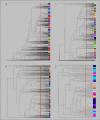Prevalence and diversity of toxigenic Clostridium perfringens and Clostridium difficile among swine herds in the midwest
- PMID: 20208029
- PMCID: PMC2863449
- DOI: 10.1128/AEM.02459-09
Prevalence and diversity of toxigenic Clostridium perfringens and Clostridium difficile among swine herds in the midwest
Abstract
Clostridium perfringens and Clostridium difficile are associated with scours in the neonatal piglet and are an economic concern in swine production. The objective of this study was to characterize the prevalence and diversity of C. perfringens and C. difficile isolates obtained from scouring neonatal piglets in a large integrated production system, as well as in smaller independently owned regional farms. Rectal swabs were collected from 333 pigs at 11 sites in an integrated swine production system and from an additional 180 pigs at 16 regional farms located throughout the Midwest. C. perfringens was isolated from 89.8% of the pigs swabbed at the integrated sites, and C. difficile was isolated from 57.7% of these pigs. Of the pigs from the regional farms sampled, 95.6% were positive for isolation of C. perfringens and 27.2% were positive for C. difficile. Toxigenic isolates were typed using random amplified polymorphic DNA (RAPD) PCR, and were placed in four dendrograms for C. perfringens and C. difficile populations isolated from the integrated sites and regional farms. Diversity indices showed that there was greater diversity in C. difficile populations and in populations isolated from the regional farms. A subset of isolates from the C. difficile dendrograms were further toxinotyped by amplification of the pathogenicity locus and subsequent digestion by HincII, AccI, and EcoRI. Of the 45 isolates typed, 44 were determined to be toxinotype V. The results of this study illustrate the diversity of C. perfringens and C. difficile isolates and the prevalence of these pathogens in swine production sites.
Figures


References
-
- Alatalo, R. 1981. Problems in the measurement of evenness in ecology. Oikos 37:199-204.
-
- Alvarez-Perez, S., J. L. Blanco, E. Bouza, P. Alba, X. Gibert, J. Maldonado, and M. E. Garcia. 2009. Prevalence of Clostridium difficile in diarrhoeic and non-diarrhoeic piglets. Vet. Microbiol. 137:203-205. - PubMed
-
- Arroyo, L. G., S. A. Kruth, B. M. Willey, H. R. Staempfli, D. E. Low, and J. S. Weese. 2005. PCR ribotyping of Clostridium difficile isolates originating from human and animal sources. J. Med. Microbiol. 54:163-166. - PubMed
-
- Baker, A., E. Davis, T. Rehberger, T. Neumann, and D. Rosener. 2007. Prevalence of virulence factors contributing to pathogenesis of Clostridium perfringens among neonatal pigs in the Midwest, abstr. Z-015, p. 92. Abstr. 107th Gen. Meet. Am. Soc. Microbiol. American Society for Microbiology, Washington, DC.
-
- Barbut, F., N. Mario, M. Delmée, J. Gozian, and J. C. Petit. 1993. Genomic fingerprinting of Clostridium difficile isolates by using a random amplified polymorphic DNA (RAPD) assay. FEMS Microbiol. Lett. 114:161-166. - PubMed
MeSH terms
LinkOut - more resources
Full Text Sources
Other Literature Sources
Molecular Biology Databases

